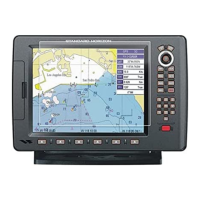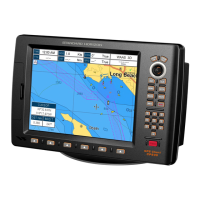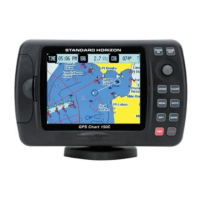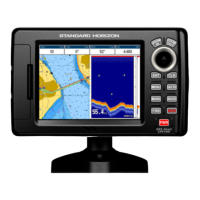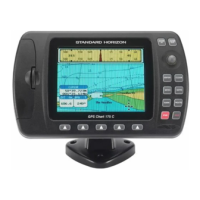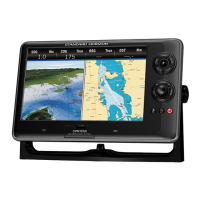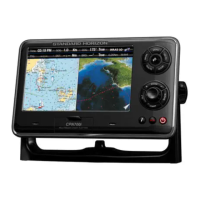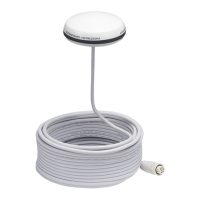Do you have a question about the Standard Horizon CPV350 and is the answer not in the manual?
Key features of the CPV350, including GPS chart plotter and marine VHF capabilities.
Guidelines for installing the VHF marine antenna to meet FCC requirements.
Instructions on how to register the CPV350 Marine VHF online for warranty.
Information on how to contact product support for technical assistance or inquiries.
Details on station licensing requirements for vessels using the radio.
Information on the requirement for a Ship Radio Station License and call sign usage.
Information on licensing requirements for vessels operating in Canada.
Technical data needed for FCC and Industry Canada license applications.
Information on mounting the GPS chartplotter using bracket or flush mounting methods.
Instructions for securely mounting the CPV350 using the provided bracket.
Identifies and describes the purpose of each connector on the rear panel of the CPV350.
How to output NMEA data (Marks, Routes, Tracks) to PC programs.
Connecting the CPV350 for outputting waypoints and routes to a PC.
Instructions for mounting the GPS WAAS Smart Antenna for optimal reception.
Details on mounting the antenna on a pole using standard threads.
Steps for flush mounting the GPS WAAS Smart Antenna for a clean installation.
Overview of C-MAP MAX evolution and key new data/presentation features.
Instructions on how to properly insert the C-MAP C-CARD into the unit.
How to access the MAX Functions menu to configure chart display options.
Setting the chart zoom mode between STANDARD and FLEXI-ZOOM.
Adjusting the size of names and symbols displayed on MAX charts.
Using C-Map MAX to display pictures or diagrams for cartographic object identification.
Identifies and explains the function of the front panel controls and connections.
How to power the unit on/off and operate the ShuttlePoint knob.
Explains the difference between Cursor Mode and Home Mode for chart navigation.
How to search for and display port services and contact information.
Lists various search functions available via C-MAP, like Port by Name/Distance.
Displaying quick information about lakes by clicking on icons.
Accessing detailed information about lakes and associated fishing data.
Step-by-step guide to creating a new mark directly on the chart page.
How to edit an existing mark, including name, icon, and color.
How to delete a MOB point from the chart.
Step-by-step guide to creating a route by selecting waypoints on the chart.
Setting up track recording intervals (time or distance) and viewing track points.
Procedure to reset the trip log to clear recorded distance and time.
Accessing the menu for managing the User C-CARD.
Steps to format the User C-CARD for preparing it to store data.
How to select display pages using the Main Menu.
How to select display pages using the Soft Keys for quick access.
Customizing the data window layout on the Chart page.
General overview of DSC's purpose in maritime distress and safety.
Transmitting a DSC position request to other vessels.
Step-by-step instructions for programming the MMSI number into the CPV350.
Detailed procedure for sending a DSC distress call with nature of distress.
How to transmit an All Ships Call (Urgency or Safety).
Programming vessel names and MMSI numbers into the individual call directory.
Enabling or disabling the call waiting feature for logged calls.
How to review logged distress and individual calls in the call waiting directory.
Programming group MMSI numbers for collective communication.
Configuring automatic or manual position replies to position requests.
Enabling or disabling the ringer for position send calls.
Customizing the names of radio channels.
Explanation of the controls and keys on the RAM+ microphone.
Using the PA/Hailer function for announcements and listen-back.
How to establish intercom communication with the VH-310 handset.
Explanation of the controls and keys on the VH-310 handset.
Using the PA/Hailer function for announcements and listen-back.
Selecting and activating fog horn signals via the VH-310 handset.
How to establish intercom communication with the VH-310 handset.
Information on ordering replacement parts like brackets and knobs.
Running an extended auto-test to help determine operational problems.
Verifying RAM integrity and options to clear internal memory and reset defaults.
Adjusting screen brightness and keypad light.
Terms and duration of the limited warranty for various marine products.
Detailed specifications for the CPV350, including general, transmitter, receiver, and GPS.
General specifications like input voltage, current drain, dimensions, and weight.
Transmitter specifications including RF output, modulation, and frequency stability.
Receiver specifications such as sensitivity, selectivity, and audio output.
GPS chart plotter specifications for user points, routes, tracks, and cartography.
| Waterproof Rating | IPX7 |
|---|---|
| Chart Plotter | Yes |
| Weight | 1.5 lbs |
| SBAS | Yes |
| Resolution | 320 x 240 pixels |
| Display Size | 5 inches |
| Display Type | LCD |
| Receiver Type | 12 Channel |
| Accuracy | 3 meters |
| Time to First Fix | Approx. 30 seconds |
| Power Supply | 12V DC |

